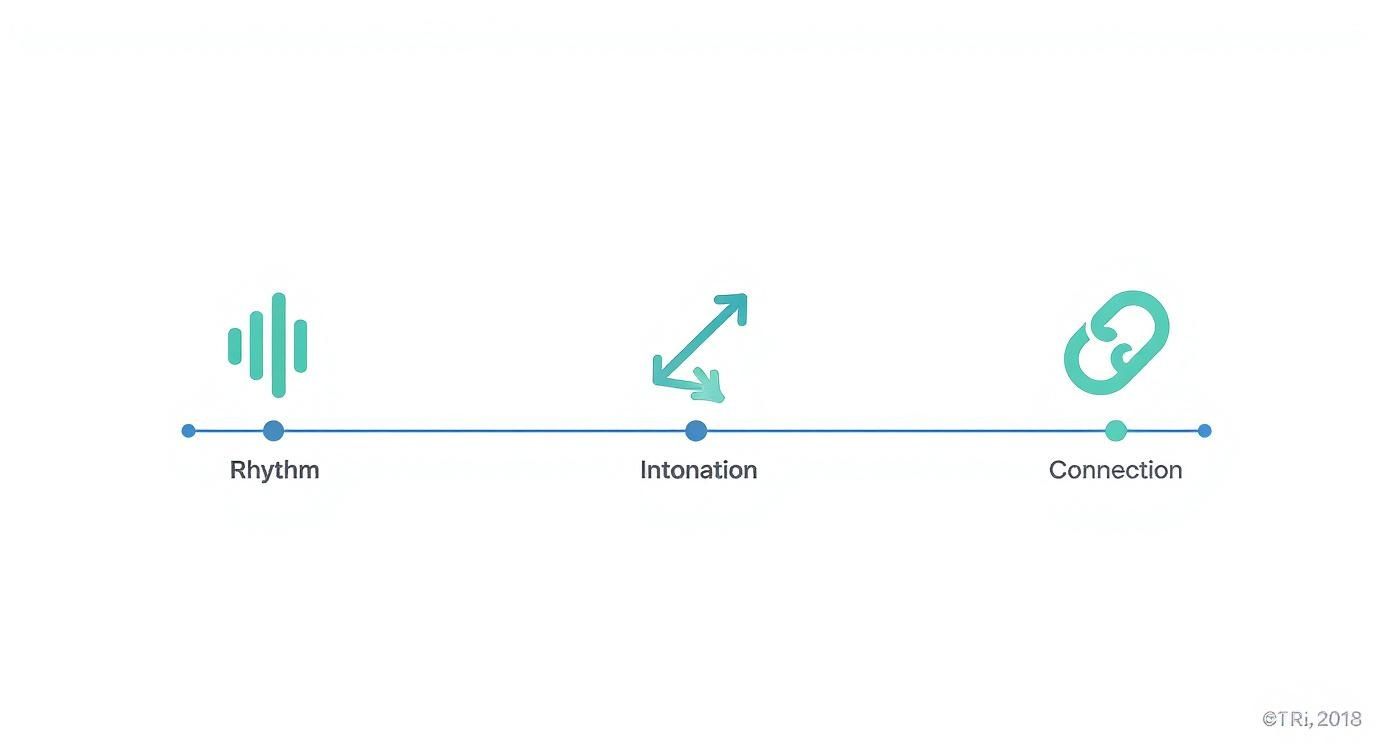American Accent Pronunciation Online Your Guide
Master American accent pronunciation online with our guide. Get practical tips, exercises, and proven methods to speak English clearly and confidently.


Learning how to pronounce words with an American accent online is easier and more effective than you might think, especially with modern, conversation-based approaches. Forget the dusty old textbooks and rigid drills; the best way to learn is by diving into the real rhythm and flow of natural speech.
Why Online Accent Training Actually Works

Ever feel like you know all the right words and grammar, but people still have trouble understanding you? It's a surprisingly common frustration. The problem usually isn't your vocabulary—it's your pronunciation.
Thankfully, the way we learn an American accent has changed for the better. We’ve finally moved past the era of just mimicking sounds from a book. The new focus is all about practical application, much like how we learned to speak as children: by listening, imitating, and actually talking.
The Shift to Conversation-First Learning
Here's a little secret from my experience: mastering a natural accent isn't about perfecting every single vowel and consonant in isolation. It's about capturing the "music" of the language—the rhythm, the stress patterns, and the intonation. These are the things you can't really get from a textbook.
That’s why effective American accent pronunciation online training puts real conversation front and center. Instead of just memorizing rules, you're thrown into actual discussions. This forces you to internalize the natural flow of English. It’s a game-changer, especially when you consider that many advanced learners still get tripped up in conversation simply because they haven't had enough speaking practice.
The real goal isn’t just to say words correctly; it’s to get your message across with clarity and confidence. Conversation-based practice is the bridge that gets you there, offering the immediate, real-world feedback you need to improve.
How Modern Platforms Make a Difference
This is where platforms like TalkEasy really shine. They're built from the ground up on this conversation-first philosophy. The technology creates a safe space where you can practice speaking your mind without that constant fear of being judged. It’s the perfect environment to build muscle memory for new sounds and speech patterns.
The benefits of this online approach are pretty clear:
- Real-Time Feedback: Getting instant corrections in the middle of a conversation helps you adjust and improve right on the spot.
- Focus on Practical Fluency: You’re not talking about abstract grammar rules. You’re discussing everyday topics, building skills you can use immediately.
- Building Confidence: Regular, low-pressure practice takes the anxiety out of speaking, which is often the biggest hurdle for learners.
When you engage in daily conversation, you're doing more than just learning an accent—you're learning how to truly connect with people. If you're ready to take the next step, our guide on English speaking practice online has even more strategies to help you get started.
Mastering Core American English Sounds

If you want to build a clear, natural-sounding American accent, you have to start with the basics. Think of it like a musician learning their scales before they can play a symphony. The individual sounds are your scales—the building blocks for every word and sentence you'll ever speak.
I’ve seen it time and again: learners get stuck on certain sounds that just don't exist in their native language. Nailing these fundamentals is the absolute first step you should take on your american accent pronunciation online journey. It makes everything that comes after so much easier.
Tackling Tricky American Vowels
Vowels are really the heart of the American accent, but they can be a real headache to get right. In many languages, vowels are quick and clipped. In American English, they’re often longer, more open, and feel a lot more relaxed in the mouth.
A perfect place to start is with the 'short a' sound, like in the words cat, apple, and back. To get this sound, you need to drop your jaw, keep your tongue low and flat, and pull the corners of your mouth back just a bit. It’s a wide, open sound that a lot of people find awkward at first.
Then you have the r-controlled vowels, which are a whole other ballgame. These are vowels where the /r/ sound that follows completely changes how the vowel is pronounced. Just listen to the difference between the 'a' in 'cat' versus 'car,' or the 'i' in 'sit' versus 'bird.' For words like car, bird, and work, the /r/ literally blends into the vowel.
A good way to practice this is to say the vowel sound by itself, and then slowly add the /r/ at the end. You should feel your tongue pulling back inside your mouth.
The secret to mastering vowels is becoming aware of your own mouth. Pay attention to your jaw, lips, and tongue. Recording yourself on your phone and comparing it to how a native speaker sounds is one of the most powerful things you can do to hear those tiny, crucial differences.
Conquering Challenging Consonants
While vowels give words their soul, consonants provide the structure and clarity. There are a few American English consonants that can trip up even the most advanced speakers. But with a little focused practice, they’re totally manageable.
Let’s talk about the American 'T'. It's famous for being a chameleon.
- Flap T: When 't' is between two vowels, like in water or better, it sounds almost like a soft 'd'. Your tongue just quickly "flaps" against the roof of your mouth.
- Glottal Stop: In words like button or mountain, the 't' sound often gets trapped in the back of the throat. You don't actually pronounce it with your tongue at all.
The 'TH' sound is another classic. It comes in two flavors: voiceless (like in think and three) and voiced (like in this and that). For both, the mechanics are the same: the tip of your tongue has to gently touch the back of your top teeth. The only difference is whether you turn on your vocal cords to make them vibrate.
This is where platforms like TalkEasy come in handy. They're built to give you practice on these specific sounds within a real conversation. You get feedback right away, so you can adjust your mouth and tongue on the spot. If you're looking for more foundational tips, check out our guide on how to improve your English accent. It’s all about building that muscle memory until these sounds feel completely natural.
The Real Secret to Sounding American
Getting every single sound right is a solid starting point, but it's not the secret to sounding like a native speaker. If you really want to master American accent pronunciation online, you have to learn the music of the language—that natural rhythm and flow that Americans use without even thinking about it.
It's a lot like learning to play an instrument. You can practice all the individual notes perfectly, but if you don't get the timing and melody right, it's just not going to sound like a real song. American English is what we call a stress-timed language. This just means that some syllables and words get more emphasis—they're held a bit longer and said with more force—while others are glossed over quickly.
This creates a distinct, almost rhythmic beat. For instance, in the sentence "I want to go to the store," the stressed words (in bold) create a predictable rhythm. Nailing this rhythm is often way more important for being understood than having a perfect vowel sound.
Using Pitch and Intonation to Add Meaning
Intonation is all about how the pitch of your voice goes up and down as you talk. This is what injects emotion and intent into your words. Get it wrong, and your speech can come across as flat, robotic, or even convey the wrong feeling entirely.
Here’s a classic example of intonation in action:
- "You're going home." (Your voice falls at the end. This is a simple statement of fact.)
- "You're going home?" (Your voice rises at the end. Now, it's a question.)
See? The words are exactly the same, but that simple shift in pitch completely changes the meaning. This is why you can't just practice from a book; you have to actively listen. Pay close attention to how people's voices change in movies or, even better, in live conversations on a platform like TalkEasy.
The goal isn't just to be understood, but to convey your message with the right emotion and intent. Mastering intonation allows you to express curiosity, certainty, surprise, and a whole range of feelings, making your speech far more engaging.
Sounding Natural with Connected Speech and Reductions
Native speakers don't pronounce every single word separately. Instead, they blend them all together into a smooth, continuous flow. We call this connected speech, and it's loaded with shortcuts that make the language sound fluid.
One common trick is linking, where the last sound of a word attaches to the first sound of the next. For example, nobody says "an... apple." It comes out sounding more like "anapple." The same goes for "turn it off"—it becomes "turnitoff."
Another huge part of sounding natural is using reductions. These are just weakened or shortened sounds that help speed things up. The most well-known examples are "going to" becoming "gonna" and "want to" becoming "wanna." These aren't slang; they're a completely normal and expected part of everyday American English.
Learning these musical elements is what will truly make your accent sound authentic. It's a goal shared by millions—in Europe alone, roughly 96% of students are learning English, with many aiming specifically for American speech patterns. You can dive deeper into these trends with these English language learning statistics.
To really get a handle on these concepts, it helps to see them all laid out. This table breaks down the core elements that give American English its unique sound and feel.
Key Elements of Natural American Speech
| Pronunciation Element | What It Means | Everyday Example |
|---|---|---|
| Word Stress | Emphasizing one syllable in a multi-syllable word. | It's COM-fort-a-ble, not com-for-TA-ble. |
| Sentence Stress | Highlighting key words in a sentence to convey meaning. | "Where are you going?" (Focus on location and action). |
| Intonation | The rise and fall of your voice's pitch. | "You're done?" (Rising pitch) vs. "You're done." (Falling pitch). |
| Linking | Connecting the end of one word to the beginning of the next. | "Come on in" sounds like "Co-mo-nin." |
| Reductions | Weakening or shortening common words for speed and flow. | "What do you want to do?" becomes "Whaddaya wanna do?" |
Once you start listening for these elements instead of just individual words, you'll hear American English in a completely new way. It’s less about mimicking and more about understanding the underlying system that makes it all work.
Building Your Online Practice Routine
Knowing the theory behind sounds and rhythm is one thing, but actually sounding like a native speaker? That comes down to one crucial element: consistency. The only way to get from textbook knowledge to natural, flowing conversation is by building a practice routine you can stick with. It’s all about creating a personal system that fits into your life and actually keeps you motivated.
While running through isolated drills has some benefits, the real breakthroughs happen when you're in a live conversation. This is precisely why a conversation-first platform like TalkEasy works so well for improving your american accent pronunciation online. When you're speaking with someone in real time, you get immediate, contextual feedback that a pre-programmed app just can't offer. It helps you take all that theory and apply it on the fly, which is where it really counts.
Crafting Your Digital Toolkit
A solid routine needs more than just one tool. Think of it like cross-training for your accent—you need a mix of resources that work on different skills to see well-rounded improvement.
Your toolkit should have a healthy mix of active and passive learning tools. Here’s what I recommend:
- Speech Recognition Apps: These are fantastic for getting an objective score on how you pronounce specific words or phrases. They’re like a personal coach you can turn to for quick, targeted drills.
- Online Dictionaries with Audio: Never just guess how a word is pronounced. Pull up a dictionary like Merriam-Webster, listen to a native speaker say the word, and then mimic it yourself a few times.
- American Movies and TV Shows: This is my favorite form of "ear training." Watching with subtitles on helps you subconsciously absorb the natural rhythm, intonation, and connected speech patterns you hear in everyday American English.
This timeline really breaks down the core musical elements of American speech that you’ll be training with these tools.

As you can see, getting the rhythm and intonation right is the foundation. Once you have that down, achieving that smooth, connected speech becomes so much easier.
A Sample Weekly Practice Schedule
Let me be clear: consistency will always win out over intensity. Practicing for a short, focused period every day is far more powerful than cramming for hours once a week.
Here’s a simple schedule you can steal and adapt for yourself:
| Day | Focus Activity (20-30 mins) |
|---|---|
| Mon/Wed | Jump on TalkEasy for active speaking practice. Pick a topic you enjoy and just talk. |
| Tue/Thu | Use a speech recognition app to drill the specific sounds you know you struggle with. |
| Friday | Time for a quick review. Record yourself reading a short paragraph and listen back. |
| Weekend | Kick back and watch 30 minutes of an American movie, actively mimicking phrases that catch your ear. |
The whole point is to create a learning ecosystem where every activity feeds into the others. Your conversations on Monday will highlight what you need to drill on Tuesday, and the movie you watch on Saturday will reinforce the natural flow you're working toward.
This kind of blended approach is what makes modern learning platforms so effective. In fact, some surveys show that 73% of learners who use services with advanced speech recognition can hold a basic conversation after only five hours. It really works. You can see more data on the effectiveness of online English courses over on Upskillist.
And if you're looking for more ways to structure your sessions, we have a whole guide on practicing English speaking online.
Making Every Conversation a Lesson

Here's where the rubber meets the road. All those drills—from individual sounds to the rhythm of sentences—are about to pay off. The single most effective way to master American accent pronunciation online is to get into real, flowing conversations. Practice drills are great for building a foundation, but they can’t get you to the finish line alone.
Live, immersive speaking is what makes new habits stick. It’s the transition from theory to practice, forcing your brain to recall and apply pronunciation rules on the fly. This is how you build the muscle memory for speech that sounds natural, not rehearsed. Think of it like this: you can practice shooting free throws for hours, but it’s playing in a real game that truly hones your skills under pressure.
Be Strategic with Your Topics
You can turn any chat into a targeted practice session if you go in with a plan. Instead of just letting conversations drift, try guiding them toward topics that feature your "problem sounds."
Struggling with the 'th' sound? You could bring up the weather, share your thoughts on a book, or chat about what you did last Thursday. If those tricky 'r-controlled' vowels are giving you trouble, talk about your career, a recent trip, or your favorite sports. You'll get tons of natural reps on words like work, partner, and first.
This simple shift turns a casual conversation into a powerful pronunciation workout, all without the pressure of a formal lesson. Platforms like TalkEasy are perfect for this, offering a space for low-key chats about pretty much anything you can think of.
The real magic of conversation practice is the context. You're not just mindlessly repeating a sound; you're using it to share a real thought. That connection helps your brain lock in the sound and use it correctly from now on.
Learning to Love Feedback
Feedback is the rocket fuel for your progress. I know it can be scary to ask for corrections, but it’s a game-changer. The trick is to stop thinking of it as criticism and start seeing it as helpful data that points you in the right direction.
When you're practicing with someone, be upfront. A simple, "Hey, I'm really working on my 't' sounds right now. If you hear me say words like water or better funny, could you let me know?" works wonders.
When you get that feedback, here's how to handle it like a pro:
- Just Listen: Don't jump in or get defensive. Let them finish.
- Repeat It Back: Say the corrected word or phrase out loud. This confirms you understood and immediately gives you a practice rep.
- Ask Why: If you're not sure what to fix, ask for specifics. "What should my tongue be doing differently on that sound?"
- Say Thanks: A genuine, "Thank you, that’s super helpful!" makes your partner feel valued and more willing to help you again.
This turns the dynamic from a test into a team effort. Your partner becomes a coach, not just a listener.
Record and Review Your Progress
One of the best tools for accent improvement is also one of the most overlooked: recording yourself. Yes, it feels a little cringe-worthy at first, but listening back to your own voice gives you a perspective you can't get any other way. You will absolutely catch habits and mistakes you had no idea you were making.
Listen with a purpose. Are you dropping the ends of words? Does your intonation sound a little flat? Are your words flowing together smoothly?
Better yet, save those recordings. Comparing one from this week to one from a month ago gives you concrete proof of how far you’ve come. Seeing that progress is a huge motivator to keep pushing forward.
Common Questions About Learning an American Accent
As you get started on your journey to improve your American accent pronunciation online, it's totally normal for a few questions to pop up. Let's walk through some of the most common concerns I hear, so you can move forward with confidence and a clear plan.
How Long Does It Take to Get an American Accent Online?
This is the big one, isn't it? The honest answer is that there's no magic number. Everyone's starting point and practice habits are different.
That said, with consistent daily practice, most learners tell me they notice a real improvement in their clarity and confidence within three to six months.
The trick isn't cramming for hours at a time. It’s all about consistency. A focused 20-30 minutes of daily conversation practice will beat a long, sporadic study session once a week, every single time. Just remember, the goal here is clear communication, not some impossible standard of perfection.
The most common mistake I see is people focusing only on individual sounds while completely ignoring the rhythm and flow of the language. You can pronounce every single word perfectly but still sound unnatural if your cadence is off.
To get around this, you need to start prioritizing the 'music' of American English. Really listen to it, and then try to mimic the flow of connected speech you hear in real conversations. Communication is about rhythm just as much as it is about individual sounds.
Can I Really Learn Without a Private Tutor?
Absolutely. A private tutor is a great option, but it's definitely not the only path to success anymore. The single most important thing you need is consistent, interactive speaking practice, and today's technology makes that incredibly accessible.
Platforms like TalkEasy are built to give you exactly that: real-time conversation with immediate feedback. This approach delivers the core benefits you'd get from tutoring—exposure, practice, and correction—but in a much more flexible and affordable way.
You get the chance to actually use what you've learned in a dynamic, real-world context. This is what truly builds lasting habits.
The key is finding a tool that provides authentic interaction. As long as you have a way to practice speaking regularly and get feedback on how you're doing, you have everything you need to successfully improve your accent online. The power to improve is genuinely in your hands.
Ready to turn these answers into action and start your journey toward clearer, more confident speech? TalkEasy provides the daily conversation practice you need to make real progress. Start speaking more naturally today at talk-easy.com.